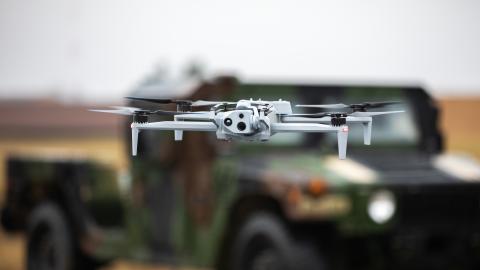The rollout of the Trump administration’s missile defense strategy has long been delayed, but on January 17, 2019, President Trump outlined his vision for missile defense in a speech at the Pentagon. The way the administration introduced the strategy piqued the interest of those tracking the moves of the Defense Department. First, the president laid out his vision himself. Second, the highest-ranking national security officials were present including Vice President Pence, Acting Secretary of Defense Patrick Shanahan, National Security Advisor John Bolton, and Air Force and Army Secretaries Heather Wilson and Mark Esper. The event was clearly meant to underscore the importance of the missile defense mission to this administration and to draw attention to the president’s statement.
His most interesting comment was on space:
bq(blockquote). [W]e will recognize that space is a new warfighting domain, with the Space Force leading the way. My upcoming budget will invest in a space-based missile defense layer. It’s new technology. It’s ultimately going to be a very, very big part of our defense and, obviously, of our offense. The system will be monitored, and we will terminate any missile launches from hostile powers, or even from powers that make a mistake. It won’t happen. Regardless of the missile type or the geographic origins of the attack, we will ensure that enemy missiles find no sanctuary on Earth or in the skies above.
This particular element of the president’s speech was more explicitly forward-leaning than the Missile Defense Review (MDR), the document that lays out the administration’s strategy for missile defense.
The MDR is the administration’s fourth document in its national security series and follows the National Security Strategy, the National Defense Strategy, and the Nuclear Posture Review, each complementing the others and providing greater specificity in different areas of strategy but all within the context of refocusing U.S. foreign policy priority and military focus and planning on great power competition.
The MDR did not state, as President Trump did, that the goal of the United States is to work toward a capability that, “regardless of the missile type or the geographic origins of the attack,” ensures “that enemy missiles find no sanctuary on Earth or in the skies above.” It didn’t exactly rule it out, either. Rather, the report explicitly says the United States won’t permit limits or constraints on “capabilities needed to protect the homeland against rogue missile threats. Accepting limits now could constrain or preclude missile defense technologies and options necessary in the future to effectively protect the American people.” President Trump, famous for his willingness to make deals, emphatically took limiting homeland missile defense off the negotiating table. He said, “We are committed to establishing a missile defense program that can shield every city in the United States. And we will never negotiate away our right to do this.” To its credit, the 2010 Obama Ballistic Missile Defense Review (BMDR) likewise said that “the Administration will continue to reject any negotiated restraints on U.S. ballistic missile defenses.” But the 2010 BMDR is a bit different than the language of the 2019 BMDR language on limits. The latest report, taken with President Trump's remarks, leads one to infer that not only will the President refuse to negotiate limits with a foreign power, the administration will not intentionally self-limit, either.
The one area some analysts may point to as conflicting with President Trump’s stated ambitions is this section of the 2019 review:
bq(blockquote). While the United States relies on deterrence to protect against large and technically sophisticated Russian and Chinese intercontinental ballistic missile threats to the U.S. homeland, U.S. active missile defense can and must outpace existing and potential rogue state offensive missile capabilities. To do so, the United States will pursue advanced missile defense concepts and technologies for homeland defense.
Note, it does not say the United States is unwilling to improve its systems such that they could have the ability to provide some defense against Russian and Chinese ICBMs; it merely notes the reality that the current deployments and capabilities are scaled to stay ahead of the rogue threat. If the United States determined to scale homeland defense against Chinese and Russian ICBMs, it need not be so robust as to have the ability to intercept every ICBM in Russia and China’s arsenal. It makes quite a bit of sense, however, to scale defenses such that they cause peer competitors to doubt whether an attack would be successful, thereby increasing the credibility of U.S. deterrence.
Also significant, the report communicates as much by what it does not say as what it does. Whereas the 2010 BMDR is quite adamant about recognizing and defending the so-called “strategic balance” between the United States, China, and Russia, those words are nowhere to be seen in the Trump MDR.
So how should one understand the latest MDR in light of the president’s characterization of it?
The MDR lays out a strategy to build on the Obama administration’s missile defense architecture, to expand the scope of missile defense in the near term, while still leaving plenty of elbow room for a more muscular missile defense system if the White House decides to pursue one. If that happens, it will be evident in the President’s budget request.
Short of that happening, the MDR sets out four modest but significant ways to improve the current missile defense architecture:
# Increase the number of missile defense assets that the U.S. deploys at home against intercontinental ballistic missiles (ICBMs) from Iran and North Korea as well as accidental and unauthorized attacks from any country;
# Develop and deploy defenses in the regional context against the most pressing missile threats from Russia and China;
# Make missile defense systems more effective as quickly as possible to compete with the dizzying speed at which adversaries are improving their offensive missiles; and
# Better utilize the space domain to make the overall missile defense architecture more effective.
On the first point, the MDR, like the president’s speech, highlights the priority of homeland defense and the addition of 20 new Ground-Based Interceptors (GBIs) that will provide added protection of the U.S. homeland from rogue ICBMs. The additional GBIs will bring the total of deployed GBIs to 64 as early as 2023. This isn’t a new development, however, since the administration requested the additional 20 interceptors in September 2017. The review also notes that the ground-based midcourse defense (GMD) system, while explicitly sized to handle the kinds of ICBM threats from North Korea and Iran, will seek to intercept an ICBM “from any source” if the country was under attack. It notes that there’s still available room for 40 more GBIs in Alaska, and that the DoD has already conducted environmental impact studies to determine candidate locations for a third interceptor site should the United States decide to increase the capacity beyond 64. The Trump MDR also notes continued investment in GMD to increase its reliability, which includes upgrading the Exoatmospheric Kill Vehicle and improving sensors. The report states that in the event of a crisis the U.S. could surge capabilities to provide greater protection. To that end, it lists the possibility of deploying THAAD, Patriot, or the SM-3 IIA, which the MDA says the U.S. will test against an ICBM-class target in 2020.
The Obama 2010 BMDR’s forward-deployed defenses were explicitly designed to defend against rogue nations’ shorter-range missiles. Having large arsenals of short and medium range missiles gives these countries a military advantage in a hypothetical—but not implausible—war with the United States. The 2019 MDR spills a good deal of ink outlining the threats from Chinese and Russian missiles in the regional context and makes explicit the intent to also defend against those threats, in particular the hypersonic missile threats.
Senior Trump Defense officials have been highlighting the unique threat posed by hypersonic weapons. As reported by Aaron Mehta of Defense News in March 2018, the Undersecretary of Defense for Research and Engineering, Mike Griffin, "warned":https://www.defensenews.com/pentagon/2018/03/06/hypersonics-highest-tec…
bq(blockquote). When the Chinese can deploy [a] tactical or regional hypersonic system, they hold at risk our carrier battle groups. They hold our entire surface fleet at risk. They hold at risk our forward-deployed forces and land-based forces… Without our ability to defend and without at least an equal response capability on the offensive side, then what we have done is we have allowed a situation to exist where our deployed forces are held at risk and we cannot do the same for them.
He continued, “And so our only response is either to let them have their way or to go nuclear. And that should be an unacceptable situation for the United States."
The Administration released the MDR shortly after it released the Defense Intelligence Agency’s "report":http://www.dia.mil/News/Articles/Article-View/Article/1732500/defense-i… on China’s military power, which lays out in much greater detail the threat China’s missile arsenal poses, especially if it decided to invade Taiwan.
In addition to providing adversaries with a military advantage in a war, missiles are also powerful in times of peace; to the extent they pose a credible threat to forward deployed U.S. forces and allies, these ever-expanding missile forces also give Russia, China, North Korea, and Iran a coercive power. Missile defenses contribute to weakening the effect of the adversaries’ coercive power and empowering the United States.
The strategy also seeks to more rapidly improve U.S. defense systems. Whereas the 2010 Obama BMDR sought to slow down or cancel what it perceived as high-risk or ineffective programs, the 2019 Trump MDR seeks to accelerate improvements and adaptations to the current systems. By necessity, this will increase the risk of missed intercepts in expensive tests, but the only way to quickly improve systems is to challenge and improve the technology. High-risk testing is unavoidable when competing with authoritarian nations that eschew plodding acquisition processes to field sophisticated technologies at a dizzying pace.
Lastly, the MDR places significant emphasis on the advantages offered by space-based missile systems, the space-based threats posed by U.S. adversaries, and how the U.S. must adapt the space domain to its own advantage. For example, the report calls out Iran for using space to further its ICBM program, as well as Russia and China for developing anti-satellite systems to hold U.S. space assets at risk.
It recognizes that, for U.S. defenses, space-based sensors “can monitor, detect and track missile launches from locations almost anywhere on the globe—they enjoy a measure of flexibility of movement that is unimpeded by the constraints that geographic limitations impose on terrestrial sensors, and can provide 'birth to death' tracking that is extremely advantageous.” Space sensors would provide the biggest leap in reliability and capability to the entire missile defense architecture in the shortest amount of time. The report notes their necessity in defending against advanced threats including hypersonic glide vehicles and hypersonic cruise missiles.
The 2019 MDR also notes, “as directed by Congress, DoD will identify the most promising technologies, and estimated schedule, cost, and personnel requirements for a possible space-based defensive layer that achieves an early operational capability for boost-phase defense.” This brings us back to the president’s far more ambitious goals for the country, which go beyond calling for studies to determine schedule and cost.
Perhaps the MDR’s modest goals will be the sum of what the country achieves in the Trump administration’s term. Even so, it will be a step in the right direction of achieving the president’s more comprehensive goals for a truly robust missile defense architecture.

















